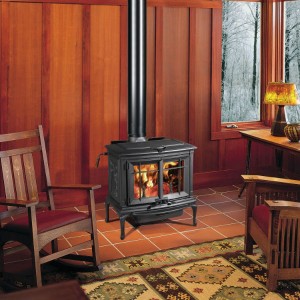Deciphering the Jargon of Your Wood Stove
Stove Size & Square foot Heating Capacity: Expected heating capacity of the stove for the Southern Maryland climate. Based on
proper wood supply, good draft, a well insulated house with 8’ ceilings, & good stove location in the house. Large and X-large stoves will
generally give you overnight burns. Manufactures heating capacity are national numbers not regional. So be careful when you read a
stove with a similar firebox size will heat 30%-40% more than a comparable model. Absolutely I can prove that a wood stove will heat a
4,000ft 2 ,well insulated house in Key West, FL. When making your decision look the firebox size chart listed below. These are heating
estimates only.
X-Large: Heating capacity up to 3000sqft. (4.0ft3 and greater)
Large: 1,800-2,200 (2.4ft3 -3.2ft3 )
Medium: 1,200-1,600 (1.6 ft3 – 2.3 ft3 )
Small: 600-1,000 (1.5ft3 or less)
BTU: Short for British Thermal Unit. Is the amount of energy needed to cool or heat one pound of water by one degree Fahrenheit. Generally equivalent to the heat generated by one match. When looking at brochures you should generally ignore these numbers, they are all over the place. EPA BTU’s are not indicative of real world use. Btu’s listed by manufacturer’s literature are not proven numbers are often the result sales meetings and not laboratory tests.
Burn Time: Reasonable expectation of how long a stove will produce usable heat. Generally speaking enough coals to ignite a new batch of firewood. Burn times can be affected by the draft of the appliance, the length, diameter, and moisture content of firewood, firebox size, and wood species of the firewood.
Log Size: Indicates how log of a piece of wood you can actually fit into the firebox. Most useful for cutting or purchasing your firewood.
Green Start Ignition System: Starting your wood stove is simple as pushing a button with this self-starting wood stove option.
Draft: Is a force that exists in a properly designed chimney system. It pulls air into the combustion chamber and expels smoke and
combustion gases from the appliance. The ability for draft to exist depends on many factors: location and height, elbows, horizontal runs,
flue size, house construction, house pressurization as well as atmospheric environmental conditions.
Bypass damper: Used to bypass the baffles inside the stove. Commonly used to start the fire and for open door burning.
Air Shutter: The air shutter can be a knob, pull handle or slide. It is used to control the amount of air flow in your stove. This will adjust
heat output and burn times. A closed air shutter will equal longer burn times, lower heat output, more creosote formation and dirty glass
(usually a dark brown color). In contrast an open air shutter will result in shorter burn times, more heat output, less creosote formation
and a glass that will generally stay clean.
